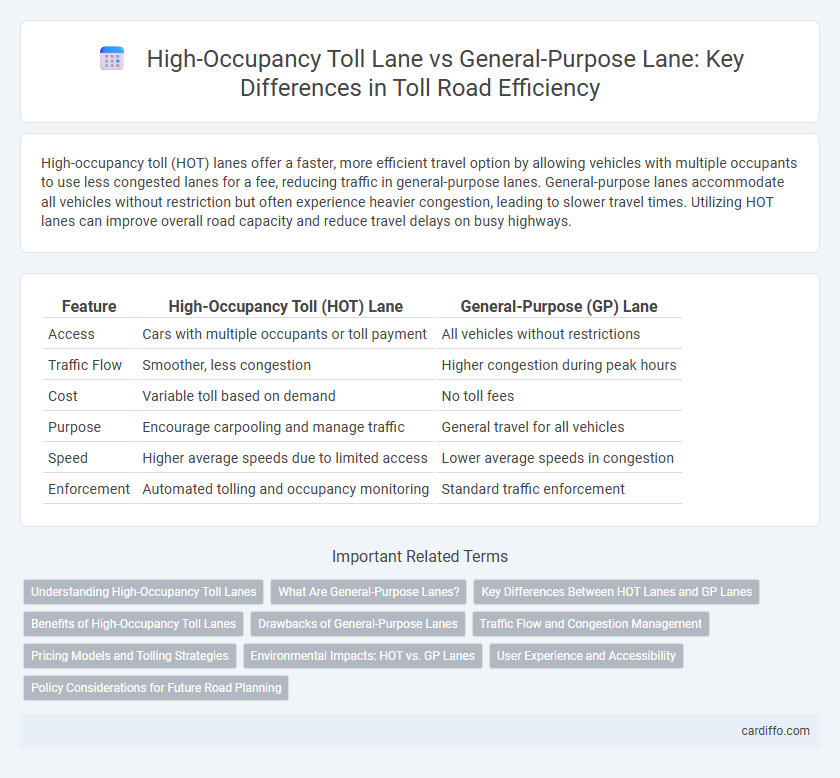High-occupancy toll (HOT) lanes offer a faster, more efficient travel option by allowing vehicles with multiple occupants to use less congested lanes for a fee, reducing traffic in general-purpose lanes. General-purpose lanes accommodate all vehicles without restriction but often experience heavier congestion, leading to slower travel times. Utilizing HOT lanes can improve overall road capacity and reduce travel delays on busy highways.
Table of Comparison
| Feature | High-Occupancy Toll (HOT) Lane | General-Purpose (GP) Lane |
|---|---|---|
| Access | Cars with multiple occupants or toll payment | All vehicles without restrictions |
| Traffic Flow | Smoother, less congestion | Higher congestion during peak hours |
| Cost | Variable toll based on demand | No toll fees |
| Purpose | Encourage carpooling and manage traffic | General travel for all vehicles |
| Speed | Higher average speeds due to limited access | Lower average speeds in congestion |
| Enforcement | Automated tolling and occupancy monitoring | Standard traffic enforcement |
Understanding High-Occupancy Toll Lanes
High-occupancy toll (HOT) lanes combine high-occupancy vehicle (HOV) benefits with toll pricing to manage traffic flow and reduce congestion effectively. These lanes allow solo drivers to use the lane by paying a variable toll, while carpools and transit vehicles typically travel free or at a reduced rate, ensuring optimal lane usage. By dynamically adjusting toll rates based on real-time traffic conditions, HOT lanes maintain smoother traffic speeds compared to general-purpose lanes, which carry all traffic types without pricing controls.
What Are General-Purpose Lanes?
General-purpose lanes accommodate all types of vehicles without restrictions, serving as the standard traffic lanes on highways and roads. They are designed to handle regular traffic volumes and do not require payment or occupancy criteria like high-occupancy toll lanes. These lanes provide essential access for daily commuters, commercial vehicles, and public transportation, maintaining a baseline flow of traffic.
Key Differences Between HOT Lanes and GP Lanes
High-occupancy toll (HOT) lanes prioritize vehicles with multiple occupants but allow single drivers to access the lane for a fee, whereas general-purpose (GP) lanes permit unrestricted access regardless of occupancy or payment. HOT lanes manage congestion by varying toll prices based on traffic volume, ensuring smoother flow and reduced travel time, while GP lanes often experience heavier congestion due to unlimited access. The key difference lies in HOT lanes' dynamic pricing and occupancy rules, designed to optimize traffic efficiency and promote carpooling compared to the uniform access model of GP lanes.
Benefits of High-Occupancy Toll Lanes
High-occupancy toll (HOT) lanes improve traffic flow by allowing vehicles with multiple occupants to use less congested lanes, reducing overall travel times. These lanes generate revenue through variable toll pricing, which funds road maintenance and transit projects without increasing taxes. HOT lanes also encourage carpooling and reduce vehicle emissions, contributing to environmental sustainability and improved air quality.
Drawbacks of General-Purpose Lanes
General-purpose lanes often suffer from increased congestion due to unrestricted access, leading to slower travel times compared to high-occupancy toll lanes designed to manage demand more effectively. These lanes lack incentives for carpooling, which results in underutilization of road capacity and higher emissions from single-occupancy vehicles. Additionally, general-purpose lanes experience greater variability in traffic flow, causing unpredictable delays and reduced overall roadway efficiency.
Traffic Flow and Congestion Management
High-occupancy toll (HOT) lanes utilize dynamic pricing to regulate traffic flow, allowing vehicles with multiple occupants to use less congested lanes by paying variable tolls based on real-time demand. This system effectively manages congestion by incentivizing carpooling and balancing lane utilization, reducing overall travel time compared to general-purpose lanes that often suffer from higher vehicle density and slower speeds. Studies show HOT lanes improve traffic throughput and maintain smoother flow, leading to more reliable commute times and decreased bottlenecks on major highways.
Pricing Models and Tolling Strategies
High-occupancy toll (HOT) lanes typically employ dynamic pricing models that adjust toll rates based on real-time traffic demand to maintain optimal vehicle speeds and minimize congestion. General-purpose lanes usually have fixed toll rates or traditional flat-rate tolling strategies that do not vary with traffic conditions, leading to less efficient traffic management. HOT lanes incentivize carpooling and transit use by allowing free or reduced toll access for eligible high-occupancy vehicles, whereas general-purpose lanes treat all vehicles uniformly without occupancy-based pricing adjustments.
Environmental Impacts: HOT vs. GP Lanes
High-occupancy toll (HOT) lanes reduce traffic congestion and vehicle emissions by encouraging carpooling and smoother traffic flow, leading to lower carbon dioxide and nitrogen oxide levels compared to general-purpose (GP) lanes. GP lanes often experience higher vehicle density and stop-and-go traffic, which increases fuel consumption and air pollution. Studies show HOT lanes contribute to improved air quality and decreased greenhouse gas emissions in urban areas.
User Experience and Accessibility
High-occupancy toll (HOT) lanes improve user experience by offering faster travel times through dynamic pricing, reducing congestion for carpoolers and solo drivers willing to pay a premium. These lanes enhance accessibility by prioritizing vehicles with multiple occupants, promoting ride-sharing and lowering commute costs for eligible users while maintaining open access for general-purpose lane drivers. General-purpose lanes, while more accessible to all drivers, often experience heavier congestion, causing longer travel times and diminished reliability compared to HOT lanes.
Policy Considerations for Future Road Planning
High-occupancy toll lanes (HOT lanes) offer dynamic pricing mechanisms that manage traffic flow by incentivizing carpooling and reducing congestion, unlike general-purpose lanes that often suffer from uncontrolled demand and increased travel times. Policy considerations for future road planning must include equitable access, where HOT lanes provide options for varying income levels through adjustable toll rates, enhancing overall network efficiency without disproportionately burdening low-income drivers. Incorporating real-time traffic data and advanced toll collection systems in HOT lane design supports sustainable urban mobility goals by optimizing lane usage and reducing environmental impact compared to traditional general-purpose lane expansion.
High-occupancy toll lane vs General-purpose lane Infographic

 cardiffo.com
cardiffo.com